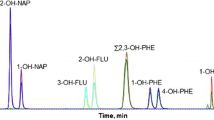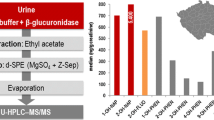Abstract
The glucuronide conjugate of 1-hydroxypyrene (1-OHP-G) is a sensitive and reliable index biomarker for assessing low exposure to polycyclic aromatic hydrocarbons (PAHs). A simple method for determining 1-OHP-G in human urine with ultra performance liquid chromatography-tandem mass spectrometry (UPLC-MS/MS) was established and applied to evaluate the exposure level of PAHs of pregnant women in a large sample size. After the urine sample was extracted with ethyl acetate, 0.2 mL of the aqueous phase was diluted to 1.0 mL with 5 mmol/L ammonium acetate before injection. The chromatographic separation was performed on a C18 column with a gradient elution and identification was conducted on a tandem mass spectrometry with electrospray ionization in negative mode. 1-OHP-d9-G was used as an internal standard to improve precision. The method was validated and good linearity was obtained in the range of 0.1∼2.0 ng/mL. The limit of detection (LOD) and the limit of quantification (LOQ) of 1-OHP-G were 0.015 and 0.051 ng/mL. Intra-day and inter-day precision were 4.3 and 6.7 %, respectively. The spiked recoveries were 79.4∼106 % for urine samples. This method was rapid, sensitive, and very suitable for batch analysis of urine. Six hundred seventy-five urine samples of pregnant women from the cities of Fuzhou, Shenzhen, and Nanning of P.R. China were analyzed with the proposed method. The medians of 1-OHP-G concentration were 0.27 μg/g.cr (n = 201), 0.30 μg/g.cr (n = 212), and 0.51 μg/g.cr (n = 262) for the cities of Fuzhou, Shenzhen, and Nanning, respectively. 1-OHP-G concentrations in urine samples of pregnant women from the cities of Fuzhou and Shenzhen in coastal areas were both significantly lower than that of Nanning City in inland region (p < 0.001).

The internal standard 1-OHP-d9-G and 2.0 mL of ethyl acetate were added to 1.0 mL of urine sample, after vortex vibration and centrifugation the aqueous phase was removed and diluted, and 5 μl of aliquot was analyzed by UPLC-MS/MS





Similar content being viewed by others
References
Kim KH, Jahan SA, Kabir E, Brown RJ. A review of airborne polycyclic aromatic hydrocarbons (PAHs) and their human health effects. Environ Int. 2013;60:71–80.
Castaño-Vinyals G, D’Errico A, Malats N, Kogevinas M. Biomarkers of exposure to polycyclic aromatic hydrocarbons from environmental air pollution. Occup Environ Med. 2004;61(4):12e–12.
Srogi K. Monitoring of environmental exposure to polycyclic aromatic hydrocarbons: a review. Environ Chem Lett. 2007;5:169–95.
Jeng HA, Pan CH. Polycyclic aromatic hydrocarbons (PAHs) 1-hydroxypyrene (1-OHP) 1-hydroxypyrene as a biomarker for environmental health. In: Preedy RV, Patel BV, editors. General methods in biomarker research and their applications. Dordrecht: Springer; 2014. p. 1–15.
Strickland P, Kang D, Sithisarankul P. Polycyclic aromatic hydrocarbon metabolites in urine as biomarkers of exposure and effect. Environ Health Perspect. 1996;104:927–32.
Perera FP, Wang S, Vishnevetsky J, Zhang B, Cole KJ, Tang D, et al. Polycyclic aromatic hydrocarbons-aromatic DNA adducts in cord blood and behavior scores in New York City children. Environ Health Perspect. 2011;119:1176–81.
Ji G, Gu A, Zhou Y, Shi X, Xia Y, Long Y, et al. Interactions between exposure to environmental polycyclic aromatic hydrocarbons and DNA repair gene polymorphisms on bulky DNA adducts in human sperm. Plos One. 2010;5(10):e1000938.
Strickland P, Kang D. Urinary 1-hydroxypyrene and other PAH metabolites as biomarkers of exposure to environmental PAH in air particulate matter. Toxicol Lett. 1999;108:191–9.
Tairova ZM, Giessing AMB, Hansen R, Andersen O. 1-Hydroxypyrene as a biomarker of PAH exposure in the marine polychaete Nereis diversicolor. Mar Environ Res. 2009;67:38–46.
Singh R, Tucek M, Maxa K, Tenglerová J, Weyand EH. A rapid and simple method for the analysis of 1-hydroxypyrene glucuronide: a potential biomarker for polycyclic aromatic hydrocarbon exposure. Carcinogenesis. 1995;16:2909–15.
Strickland PT, Kang D, Bowman ED, Fitzwilliam A, Downing TE, Rothman N, et al. Identification of 1-hydroxypyrene glucuronide as a major pyrene metabolite in human urine by synchronous fluorescence spectroscopy and gas chromatography–mass spectrometry. Carcinogenesis. 1994;15:483–7.
Yoon HS, Lee KM, Lee KH, Kim S, Choi K, Kang D. Polycyclic aromatic hydrocarbon (1-OHPG and 2-naphthol) and oxidative stress (malondialdehyde) biomarkers in urine among Korean adults and children. Int J Hyg Environ Heath. 2012;215:458–64.
Fagundes RB, Abnet CC, Strickland PT, Kamangar F, Roth MJ, Taylor PR, et al. Higher urine 1-hydroxy pyrene glucuronide (1-OHPG) is associated with tobacco smoke exposure and drinking mate in healthy subjects from Rio Grande do Sul, Brazil. BMC Cancer. 2006;6:139–46.
Lee KH, Vermeulen R, Lenters V, Cho SH, Strickland PT, Kang D. Determinants of urinary 1-hydroxypyrene glucuronide in South Korean children. Int Arch Occup Environ Heath. 2009;82:961–8.
Roth MJ, Qiao Y-L, Rothman N, Tangrea JA, Dawsey SM, Wang G-Q, et al. High urine 1-hydroxypyrene glucuronide concentrations in Linxian, China, an area of high risk for squamous oesophageal cancer. Biomarkers. 2001;6:381–6.
Lee CK, Cho SH, Kang JW, Lee SJ, Ju YS, Sung J, et al. Comparison of three analytical methods for 1-hydroxypyrene glucuronide in urine after non-occupational exposure to polycyclic aromatic hydrocarbons. Toxicol Lett. 1999;108:209–15.
Giessing AMB, Lund T. Identification of 1-hydroxypyrene glucuronide in tissue of marine polychaete Nereis diversicolor by liquid chromatography/ion trap multiple mass spectrometry. Rapid Commun Mass Spectrom. 2002;16:1521–5.
Kakimoto K, Toriba A, Ohno T, Ueno M, Kameda T, Tang N, et al. Direct measurement of the glucuronide conjugate of 1-hydroxypyrene in human urine by using liquid chromatography with tandem mass spectrometry. J Chromatogr B. 2008;867:259–63.
Author information
Authors and Affiliations
Corresponding author
Ethics declarations
Conflict of interest
We declare that there is no conflict of interest in this article.
Informed consent of all individual participants who provided urine samples was obtained.
Rights and permissions
About this article
Cite this article
Li, M., Wang, Q., Zhu, J. et al. A simple analytical method of determining 1-hydroxypyrene glucuronide in human urine by isotope dilution with ultra performance liquid chromatography-tandem mass spectrometry. Anal Bioanal Chem 409, 1513–1518 (2017). https://doi.org/10.1007/s00216-016-0083-y
Received:
Revised:
Accepted:
Published:
Issue Date:
DOI: https://doi.org/10.1007/s00216-016-0083-y




